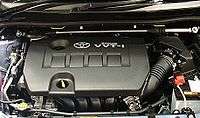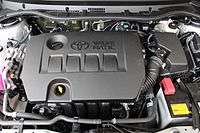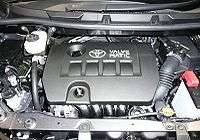Toyota ZR engine

The ZR engine gasoline-engine-family, introduced in 2007 by Toyota Motor Corporation, uses a DOHC 16-valve cylinder head with a 4-cylinder die-cast block. Engines displace either 1.6-liters, 1.8-liters or 2.0-liters. All engines in this family are equipped with Toyota's dual VVT-i technology that optimizes both intake and exhaust valve timing. This engine family is also the first to use Toyota's Valvematic system, first appearing on the Noah and Voxy in 2007 and then the European Avensis in 2009.
1ZR-FE
The Toyota 1ZR-FE is a DOHC, 16-valve, 1.6 L (1598cc) engine equipped with dual VVT-i. This engine is available with either manual gearbox (5 Speed) or a "multi-mode" manual transmission (MM-T 5 Speed). This new engine is now replacing the 3ZZ-FE engine in most applications. Output for this engine is rated at 122 hp (91 kW) at 6000 rpm and 113 lb⋅ft (153 N⋅m) of torque at 5200 rpm net.
- Specifications
- Engine type : In-Line 4-cylinder DOHC 16-valve
- Bore x Stroke : 80.5 x 78.5 mm
- Compression Ratio : 10.2:1
- Applications
- Toyota Auris (ZRE151) (Europe only)
- Toyota Corolla (ZRE140, ZRE151) (Europe, Middle East)
- Toyota Corolla Altis (ZRE141) (Facelift; Asia only)
- Toyota Vios (China)
1ZR-FAE
The Toyota 1ZR-FAE is a DOHC, 16-valve, 1.6 L (1,598 cc) engine also equipped with Dual VVT-i and Valvematic. Output for this engine is rated at 132 hp (97 kW) at 6400 rpm and 118 lb·ft (160 N·m) of torque at 4400 rpm for the Avensis. Compression ratio has been increased to 10.7:1, red line is at 6600 rpm. Valvematic varies the intake valve lift between 1mm and 11mm according to load and RPM.[1]
- Applications
- Toyota Auris (ZRE151) (Europe only)
- Toyota Corolla (ZRE181) (Europe only)
- Toyota Avensis (ZRT270)
- Toyota Verso (ZGR20)
- Lotus Elise (2010-current)
1ZR-FBE
The Toyota 1ZR-FBE is A flex fuel version of the 1ZR-FE the DOHC, 16-valve, 1.6 L (1,598 cc) engine also equipped with Dual VVT-i and Valvematic. Output for this engine is rated at 125 hp (92 kW) at 6000 rpm and 116 lb·ft (157 N·m) of torque at 5200 rpm.
- Applications
- Toyota Corolla (ZRE170) (Southeast Asia only)
2ZR-FE
The Toyota 2ZR-FE is a DOHC, 16-valve, 1.8 L (1798 cc)[2] engine also equipped with Dual VVT-i.
This new engine is now replacing the 1ZZ-FE engine in most applications.[3] Output for this engine is rated at 98–103 kW (132–138 hp) at 6000 rpm and 173 N⋅m (127.5 lb⋅ft) of torque at 4400 rpm for the Corolla, Matrix, and Vibe and 95 kW (128 hp) and 171 N⋅m (126 lb⋅ft) of torque in the Scion xD.
- Specifications
- Engine Type : In-Line 4-cylinder DOHC 16-valve
- Bore × Stroke = 80.5 mm × 88.3 mm (3.169 in × 3.476 in)
- Compression Ratio : 10.0:1
- Weight : 97 kg (214 lb), without fuel
- 15.2 km/L (43 mpg‑imp; 36 mpg‑US) fuel consumption (10-15 Australia & New Zealand test cycle)
- Applications
- Toyota Allion (ZRT260/265) 2007-2009
- Toyota Premio (ZRT260/265) 2007-2009
- Toyota Corolla (ZRE142/152)
- Toyota Corolla (ZRE172) (132 hp for all markets except 138 hp Corolla Altis for Asia-Pacific market)
- Toyota Corolla Axio/Fielder (NZE141) (Japan only)
- Toyota Corolla Axio/Fielder (NZE161) (Japan only)
- Toyota Corolla Hatchback (ZRE182/ZRE182R)
- Toyota Auris (ZRE152/154)
- Toyota Yaris (ZSP90) (Europe only)
- Toyota Matrix/Pontiac Vibe (ZRE142) (North America only)
- Toyota Yaris GRMN with supercharger (205 hp)
- Scion xD (ZSP110)
- Lotus Elise Model Year >= 2012 with Magnuson R900 supercharger (217bhp)
2ZR-FAE

The Toyota 2ZR-FAE is a DOHC, 16-valve, 1.8 L (1797 cc) this engine adopts the Valvematic system. This all-new engine is progressively replacing the 1ZZ-FED and 2ZR-FE engine in most applications. Variants of this engine produce 104–110 kW (139–148 bhp) and 171–175 N⋅m (126–129 lbf⋅ft) of torque. Compression ratio is 10.5:1 and redline is at 6600 rpm. The engine consumes 5–10% less fuel than the 2ZR-FE depending on the application.[4]
A special version of the 2ZR-FAE was introduced by Toyota in 2016 for the Taiwanese version of the Toyota Sienta. Unlike the original 2ZR-FAE, this version was created by simply adding the Valvematic system to the standard 2ZR-FE engine used in the Toyota Corolla Altis sold there, resulting in total power of 140 PS (103 kW; 138 hp) at 6200 rpm and a peak torque of 172 N⋅m (17.5 kg⋅m) at 4000 rpm.[5]
- Applications
- Toyota Auris (ZRE152) (Europe and Japan only)
- Toyota Avensis (ZRT271)
- Toyota Corolla (ZRE172) LE Eco only
- Toyota Corolla Rumion (ZRE152/154) (Japan only)
- Toyota iSt (ZSP110) (Japan only)
- Toyota Wish (ZGE20/25)
- Toyota Verso (ZGR21)
- Toyota Allion (ZRT260/265) 2010-current
- Toyota Premio (ZRT260/265) 2010-current
- Scion iM[6] 2016
- Toyota Corolla iM[7] 2017-current
- Toyota Sienta (ZVP170) October 2016-current (Taiwan only)
2ZR-FBE
The Toyota 2ZR-FBE is A flex fuel version of the 2ZR-FE the DOHC, 16-valve, 1.8 L (1,798 cc) engine also equipped with Dual VVT-i and Valvematic. Output for this engine is rated at 141 hp (104 kW) at 6000 rpm and 131 lb·ft (177 N·m) of torque at 4000 rpm.
- Applications
- Toyota Corolla (ZRE170) (Brazil and Southeast Asia only)
- Toyota C-HR (NGX10R) (Indonesia, Malaysia & Thailand only)
2ZR-FXE
The Toyota 2ZR-FXE is a 1.8 L (1798 cc) Atkinson cycle variant of the 2ZR-FE.[8] It has the same bore and stroke, but the compression ratio is increased to 13.0:1, and the inlet valve closing is retarded. The net result is that the engine has a greater effective expansion than compression. Output is 73 kW (98 hp) and 142 N⋅m (105 lb⋅ft) of torque, paired with electric motor/generators in the hybrid drive system; together the engine and electric motors produce up to 100 kW (134 hp) and 207 N⋅m (153 lb⋅ft). Thermal efficiency is about 38.5%.[9]
For the 2016 Toyota Prius, output is 95 hp at 5200 rpm and 142 N·m (105 lb·ft) of torque at 3600 rpm, or when paired with electric motor/generators 53 kW (71 hp) and 120 lb·ft of torque in the hybrid drive system; together the engine and electric motors produce up to 121 hp. Thermal efficiency is about 40%.
- Applications
- 2016 Toyota Prius (2WD: ZVW50, ZVW51 and E-Four: ZVW55)
- 2016 Toyota C-HR hybrid
- 2012 Toyota Prius v
- 2011 Lexus CT200h
- 2010 Toyota Auris/Toyota Corolla Hatchback Hybrid
- 2010 Toyota Prius (ZVW30)
- 2017 Toyota C-HR Hybrid (NGX10R)
- 2014 Toyota Voxy Hybrid
(R80)
3ZR-FE
The Toyota 3ZR-FE is a 2.0 L (1,986cc) DOHC, 16-valve engine with Dual VVT-i.
- Specifications
- Engine type : In-Line 4-cylinder DOHC 16-valve
- Bore x Stroke : 80.5 × 97.6 mm
- Compression Ratio : 10.0:1 (Japan)
- 143 PS (141 hp; 105 kW) at 5600 rpm (Japan)
- 142–153 PS (140–151 hp; 104–113 kW) at 5800rpm (Brazil, Flex Fuel Version E22/E100 Fuel)
- 194 N⋅m (143.1 lb⋅ft; 19.8 kg⋅m) of torque at 3900 rpm (Japan)
- 194–203 N⋅m (143.1–149.7 lb⋅ft; 19.8–20.7 kg⋅m) 194 / 203 N·m @ 4000 rpm (Brazil, Flex Fuel Version E22/E100 Fuel)
- 13.4 km/L (37.9 mpg‑imp; 31.5 mpg‑US) fuel consumption (10-15 Japanese test cycle: Toyota Voxy; Toyota Noah)
- Applications
- 2007 Toyota Voxy (ZRR70/75)
- 2007 Toyota Noah (ZRR70/75)
- Toyota Avensis (ZRT272) (ex. Europe)
- 2009 Toyota Corolla Altis (ZRE143) (Asia-Pacific ex. Japan)
- 2010 Toyota Corolla XEi (E150) (Brazil)
- 2013 Toyota RAV4 (ZSA42L/44L)
- 2013 Toyota Corolla (E170) (Middle East)
3ZR-FAE

The 3ZR-FAE is a 2.0 L (1,987cc) DOHC, 16-valve engine that was first used in 2007. It is Toyota's first engine with the Valvematic variable lift intake system.
- Specifications
- Engine type : In-Line 4-cylinder DOHC 16-valve
- 144bhp & 138lb feet torque
- Bore x Stroke : 80.5 × 97.6 mm
- Compression Ratio : 10.0:1
- 158 PS (155 hp/116 kW) at 6200 rpm
- 144 lb⋅ft (195 N⋅m) of torque 4400 rpm
- 33 mpg
- 14.2 km/L fuel consumption (10-15 Japanese test cycle)
- 164 g/km of CO² emissions
- Applications
- Toyota Allion (ZRT261)
- Toyota Premio (ZRT261)
- Toyota RAV4 (ZSA30/35) (Europe and Central America)
- Toyota Avensis (ZRT272)
- Toyota Wish (ZGE21/22)
- Toyota Voxy (ZRR70/75)
- Toyota C-HR (2404/06) (US and Canada only)
3ZR-FBE
A flex fuel version of the 3ZR-FE was released in March 2010 in Brazil with 142 PS (104 kW; 140 bhp) when running on petrol, and 153 PS (113 kW; 151 bhp) on ethanol .[10][11]
- Applications
- Toyota Corolla (Brazil, 2010)
4ZR-FE
The Toyota 4ZR-FE is a 1.6 L (1,598cc) DOHC, 16-valve engine with Dual VVT-i. Output for this engine is rated at 87 kW (117 hp) at 6000 rpm and 150 N·m of torque at 4400 rpm. It is very similar to 1ZR-FE.
- Applications
- Toyota Corolla EX (ZRE120) (China only)
- Toyota Yaris (ZSP91) (China only)
- Toyota Vios (ZSP92) (China only)
5ZR-FXE
- Specifications
- Type: inline 4 cylinder DOHC 16 valve VVT-i Atkinson cycle
- Exhaust volume: 1.798 L
- Bore x stroke: 80.5×88.3 mm
- Compression ratio: 13.0
- Output: 73 kW (99 PS) at 5,200 rpm; torque: 142 N⋅m (14.5 kg⋅m) at 4,000 rpm
- Applications
Specification is similar to 2ZR-FXE & a region-coded model due to various reasons.
8ZR-FXE
- Specifications
- Type: inline 4 cylinder DOHC 16 valve VVT-i Atkinson cycle
- Exhaust volume: 1.798 L
- Bore x stroke: 80.5×88.3 mm
- Compression ratio: 13.0
- Output: 73 kW (99 PS) at 5,200 rpm; torque: 142 N⋅m (14.5 kg⋅m) at 4,000 rpm
- Applications
- 2015- Toyota Corolla (E170) hybrid (China variants)
- 2015- Toyota Levin (E170) hybrid (China variants)
Production
The 1.6L and 1.8L ZR engines are built in Tianjin FAW Toyota Engine Co., Ltd. (TFTE) Plant No. 2, beginning in April 2007 [12] and in the West Virginia Plant for Corolla's production in the United States and Canada.[13]
See also
| Wikimedia Commons has media related to Toyota ZR engines. |
References
- ↑ "Avensis press pack - tech spec" (PDF) (Press release). UK: Toyota. Archived from the original (PDF) on 2011-04-03.
- ↑ "The Unexpected: Toyota Reveals the Stunning Next-Generation Corolla Sedan" (Press release). USA: Toyota. 2013-06-06. Retrieved 2013-07-08.
- ↑ "Toyota Reinforces Efforts for Environmental Technologies and Environmentally Friendly Vehicles" (Press release). Japan: Toyota. 2006-06-13.
- ↑ "PREMIO/TOYOTA|Spec". Minkara - The Car & Automobile SNS (in Japanese). Retrieved 2014-06-13.
- ↑ Ai, Sa-Ke (2016-11-25). "打破尺寸界限 Toyota Sienta國內首試報導" [Breaking Size Boundaries – Toyota Sienta Domestic First Trial Report]. Mobile01 (in Chinese). Retrieved 2017-04-09.
- ↑ "2016 iM" (PDF) (Press release). Canada: Scion. Retrieved 2018-04-02.
- ↑ "2017 Corolla" (PDF) (Press release). Canada: Toyota. Retrieved 2018-04-02.
- ↑ "2010 Prius Product Information" (Press release). USA: Toyota. Retrieved 2014-06-13.
- ↑ "Toyota targeting thermal efficiency of more than 45% for next-generation gasoline engines for hybrids". Green Car Congress. 2011-04-11. Retrieved 2015-05-03.
- ↑ "Toyota Corolla passa a ter dois motores flex e novo sobrenome na versão mais cara" (in Portuguese). UOL. 2010-03-17. Retrieved 2017-05-18.
- ↑ "Toyota Corolla XEi 2.0 AT" (in Portuguese). CarrosnaWeb. Retrieved 2017-05-18.
- ↑ "Tianjin FAW Toyota Engine's Plant No. 2 to Mark Engine Production Start" (Press release). Japan: Toyota. 2007-04-20. Retrieved 2014-06-13.
- ↑ "Overview of Overseas Production Affiliates | North America". Toyota. Retrieved 2014-06-13.